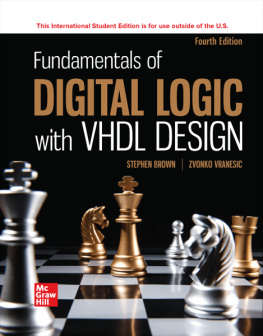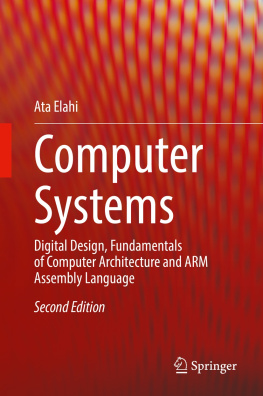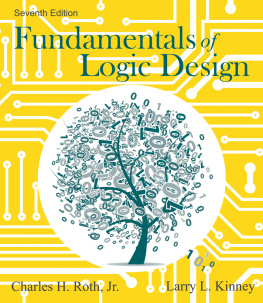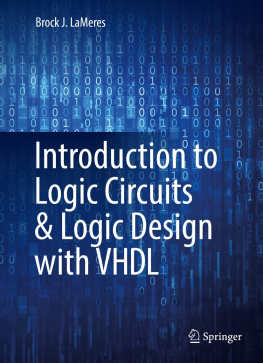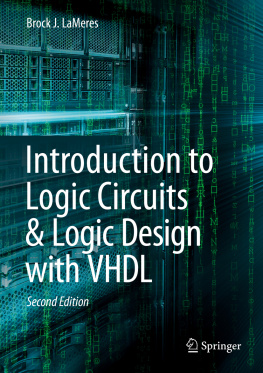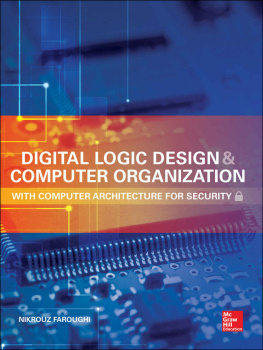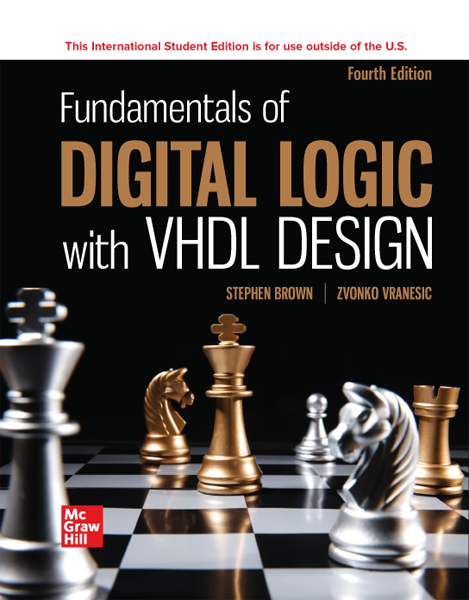
page i
F undamentals
of
D igital L ogic with VHDL D esign

FOURTH EDITION
Stephen Brown and Zvonko Vranesic
Department of Electrical and Computer Engineering
University of Toronto

page ii

FUNDAMENTALS OF DIGITAL LOGIC WITH VHDL DESIGN
Published by McGraw Hill LLC, 1325 Avenue of the Americas, New York, NY 10019. Copyright c 2023 by McGraw Hill LLC. All rights reserved. Printed in the United States of America. No part of this publication may be reproduced or distributed in any form or by any means, or stored in a database or retrieval system, without the prior written consent of McGraw Hill LLC, including, but not limited to, in any network or other electronic storage or transmission, or broadcast for distance learning.
Some ancillaries, including electronic and print components, may not be available to customers outside the United States.
This book is printed on acid-free paper.
1 2 3 4 5 6 7 8 9 LCR 27 26 25 24 23 22
ISBN 978-1-260-59778-3
MHID 1-260-59778-4
Cover Image: View Stock/Getty Images
All credits appearing on page or at the end of the book are considered to be an extension of the copyright page.
The Internet addresses listed in the text were accurate at the time of publication. The inclusion of a website does not indicate an endorsement by the authors or McGraw Hill LLC, and McGraw Hill LLC does not guarantee the accuracy of the information presented at these sites.
mheducation.com/highered
page iii
To Susan and Anne
page iv
page v
A bout the A uthors
Stephen Brown received the Ph.D. and M.A.Sc. degrees in Electrical Engineering from the University of Toronto, and his B.A.Sc. degree in Electrical Engineering from the University of New Brunswick. He joined the University of Toronto faculty in 1992, where he is now a Professor in the Department of Electrical & Computer Engineering. He is also the Director of FPGA Academic Programs for Intel Corporation.
His research interests include field-programmable VLSI technology, CAD algorithms, computer architecture, and applications of machine learning. He won the Canadian Natural Sciences and Engineering Research Council's 1992 Doctoral Prize for the best Ph.D. thesis in Canada, and the New Brunswick Governor-General's 1985 award for the highest academic standing in the Faculty of Engineering. He is a coauthor of more than 150 scientific research papers and two other textbooks: Fundamentals of Digital Logic with Verilog Design and Field-Programmable Gate Arrays.
He has won many awards for excellence in teaching electrical engineering, computer engineering, and computer science courses.
Zvonko Vranesic received his B.A.Sc., M.A.Sc., and Ph.D. degrees, all in Electrical Engineering, from the University of Toronto. From 1963 to 1965 he worked as a design engineer with the Northern Electric Co. Ltd. in Bramalea, Ontario. In 1968 he joined the University of Toronto, where he is now a Professor Emeritus in the Department of Electrical & Computer Engineering. During the 1978-79 academic year, he was a Senior Visitor at the University of Cambridge, England, and during 1984-85 he was at the University of Paris, 6. From 1995 to 2000 he served as Chair of the Division of Engineering Science at the University of Toronto.
He is a coauthor of four other books: Computer Organization and Embedded Systems, 6th ed.; Fundamentals of Digital Logic with Verilog Design, 3rd ed.; Microcomputer Structures; and Field-Programmable Gate Arrays. In 1990, he received the Wighton Fellowship for "innovative and distinctive contributions to undergraduate laboratory instruction." In 2004, he received the Faculty Teaching Award from the Faculty of Applied Science and Engineering at the University of Toronto.
He has represented Canada in numerous chess competitions. He holds the title of International Master.
page vi
P reface
This book is intended for an introductory course in digital logic design, which is a basic course in most electrical and computer engineering programs. A successful designer of digital logic circuits needs a good understanding of the classical methods of logic design and a firm grasp of the modern design approach that relies on computer-aided design (CAD) tools.
The main goals of this book are (1) to teach students the fundamental concepts of classical manual digital design and (2) illustrate clearly the way in which digital circuits are designed today, using CAD tools. Even though current modern designers very rarely use manual techniques, our motivation for teaching such techniques is to give students an intuitive feeling for how digital circuits operate. The manual techniques also provide an illustration of the types of manipulations performed by CAD tools, giving students an appreciation of the benefits provided by design automation. Throughout the book, basic concepts are introduced by way of simple design examples, which we perform using both manual techniques and modern CAD-tool-based methods. After basic concepts are established, more complex examples are provided using the CAD tools. Thus, to illustrate how digital design is presently carried out in practice, our emphasis is on modern design methodology.
T echnology
This book discusses modern digital circuit implementation technologies. The emphasis is placed on programmable logic devices (PLDs), which is the most appropriate technology for use in a textbook for two reasons. First, PLDs are widely used in practice and are suitable for almost all types of digital circuit designs. In fact, students are more likely to be involved in PLD-based designs at some point in their careers than in any other technology. Second, circuits are implemented in PLDs by end-user programming. Therefore, students can be provided with the opportunity, in a laboratory setting, to implement this book's design examples in actual chips. Students can also simulate the behavior of their designed circuits on their own computers. We use the two most popular types of PLDs for targeting of designs: complex programmable logic devices (CPLDs) and field-programmable gate arrays (FPGAs).
We emphasize the use of a hardware description language (HDL) in specifying the logic circuits, because an HDL-based approach is the most efficient design method to use in practice. We describe in detail the IEEE Standard VHDL language and use it extensively in examples.
S cope of the B ook
This edition of the book has been extensively restructured. All of the material that should be covered in a one-semester course is now included in .
page vii
provides a general introduction to the process of designing digital systems. It discusses the key steps in the design process and explains how CAD tools can be used to automate many of the required tasks. It also introduces the representation of digital information.
introduces logic circuits. It shows how Boolean algebra is used to represent such circuits. It introduces the concepts of logic circuit synthesis and optimization, and shows how logic gates are used to implement simple circuits. It also gives the reader a first glimpse at VHDL, as an example of a hardware description language that may be used to specify the logic circuits.
concentrates on circuits that perform arithmetic operations. It discusses numbers and shows how they can be manipulated using logic circuits. This chapter illustrates how VHDL can be used to specify a desired functionality and how CAD tools can provide a mechanism for developing the required circuits.
presents combinational circuits such as multiplexers, encoders, and decoders that are used as building blocks in larger circuits. These circuits are very convenient for illustrating the application of many VHDL constructs, giving the reader the opportunity to discover more advanced features of VHDL.
Next page
